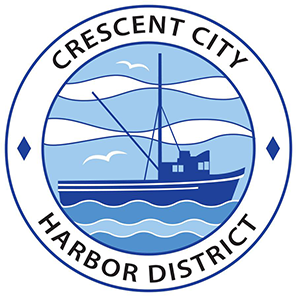August 1, 2025 - Crescent City Harbor District Releases Preliminary Tsunami Damage Assessment
FOR IMMEDIATE RELEASE
Date: August 1, 2025
Crescent City, CA — The Crescent City Harbor District has released a preliminary assessment of the tsunami-related damage sustained during the early morning hours of July 30, 2025. While no injuries were reported and core harbor infrastructure remains operational, "H" Dock and several other areas experienced significant damage, particularly to electrical, water, and fire suppression utility systems.
Initial repair costs are estimated to approach $1 million, based on structural failures, environmental permitting requirements, and the complexity of underwater repairs. A full summary of the incident and projected repairs can be found in the narrative below, along with a link to photographs of damaged areas. The Harbor District is actively working with local, state, and federal partners to secure resources for recovery and ensure safe restoration of affected infrastructure.
Photographs of representative damage can be viewed here: 2025 Tsunami
As previously reported, at approximately 2:40 AM, Crescent City Harbor sustained significant tsunami-related damage, primarily affecting "H" Dock. A surge of water several feet in height caused the dock's floating concrete decking to lift along its pilings. As water levels continued to rise, the structural system was unable to accommodate the vertical displacement induced by the surge. The floating decking became impinged on the guide pilings and was temporarily submerged, resulting in segment separation and progressive structural failure.
During the incident, electrical arcing and sparking were observed, consistent with the subsequent finding that electrical conduits running through the center of the dock were severely compromised. In many locations, the outer insulation was torn away, leaving live copper wiring exposed. Serious damage was also sustained to potable water lines and large-diameter fire suppression plumbing lines, which have been ripped apart, across multiple docks. While it is apparent that "H" Dock sustained the most damage, random utility damage is evident throughout the dock system. The full extent of damage remains difficult to assess due to water turbidity and the need for diver crews to make detailed observations.
In addition to the structural and utility damage, the tsunami surge events deposited a significant volume of sediment and debris throughout portions of the harbor basin. Preliminary observations indicate that navigation channels and vessel berthing areas have experienced measurable shoaling, reducing the available depth needed for safe vessel access and maneuvering. As part of the recovery effort, dredging operations will be required to restore original design depths and ensure the harbor remains fully navigable. A hydrographic survey will be conducted to quantify sediment displacement and guide the development of a dredging plan that complies with environmental regulations and sediment disposal requirements.
Repair efforts will be focused on accessing utility corridors encased within or beneath the large concrete dock segments. This will require crane operations to physically lift sections of dock, an effort that entails barge staging, heavy marine equipment, and skilled crews. In parallel, diver teams will be deployed to inspect and reconnect underwater infrastructure.
Additional costs contributing to the overall repair estimate include the replacement of damaged electrical transformers, environmental compliance and permitting, and engineering design and review by marine engineers. Finally, the work itself involves specialized labor and materials for marine construction and underwater utility repair, activities that are more costly than comparable land-based work due to the need for cranes, barges, divers, and marine-rated equipment.
While steel pilings in the Inner Boat Basin appear largely undamaged, Citizens Dock sustained more serious structural damage to its wooden pilings and cross members. At least three impacted components appear to have been fully dislodged and swept away, with others partially damaged remaining in place.
It's important to understand this damage within the broader context of harbor design. Following the far more catastrophic tsunami of 2011, the Inner Boat Basin was completely reconstructed to modern tsunami-resilient standards, using 30-inch steel pilings encased in HDPE sleeves, driven deep into bedrock to maximize stability. These modern pilings replaced the 16-inch diameter pilings used in the previous dock structure and were driven significantly deeper—between 21 and 37 feet into bedrock, compared to just 10 feet in the earlier design—providing greatly enhanced stability and resilience. H Dock, specifically, was engineered as a wave and current attenuator, with closely spaced pilings designed to absorb and dissipate energy before it reached the interior docks. In this event, H dock functioned as designed—sacrificing itself to protect other infrastructure.
Although the estimated $1 million in damage to embedded utilities and dock structures is significant, it stands in stark contrast to the $50 million in damages sustained in 2011. This outcome is a testament to effective engineering for tsunami resilience and responsible stewardship of public resources implemented in the aftermath of the 2011 tsunami. Thanks to the reengineered dock system, both commercial and recreational vessels were spared from damage during the recent tsunami surge. In contrast to the 2011 event—when vessels were repeatedly slammed against docks and one another in a destructive 'pinball machine' effect—the new attenuator design and deeper pilings helped absorb and dissipate wave energy, preventing a similar cascade of vessel collisions.
The Crescent City Harbor District remains committed to a coordinated recovery effort, and we are working closely with local, state, and federal partners to assess the full extent of the damage, secure disaster assistance, and expedite critical repairs while maintaining public safety and environmental stewardship. The outpouring of support from our community, harbor users, and agency partners has been deeply appreciated and reinforces our resolve to rebuild stronger than before. Once again, the tsunami-resilient design features implemented after the 2011 disaster—particularly the reengineered pilings and attenuator configuration of H Dock—performed as intended, helping to absorb the brunt of the surge energy and prevent even more catastrophic damage to the inner harbor. As additional information becomes available, the Harbor District will continue to provide timely updates and work in partnership with our stakeholders to ensure a safe and successful recovery.
Mike Rademaker, CEO/Harbormaster
Phone: 707.464.6174
Email: mrademaker@ccharbor.com
Website: https://www.ccharbor.com/
